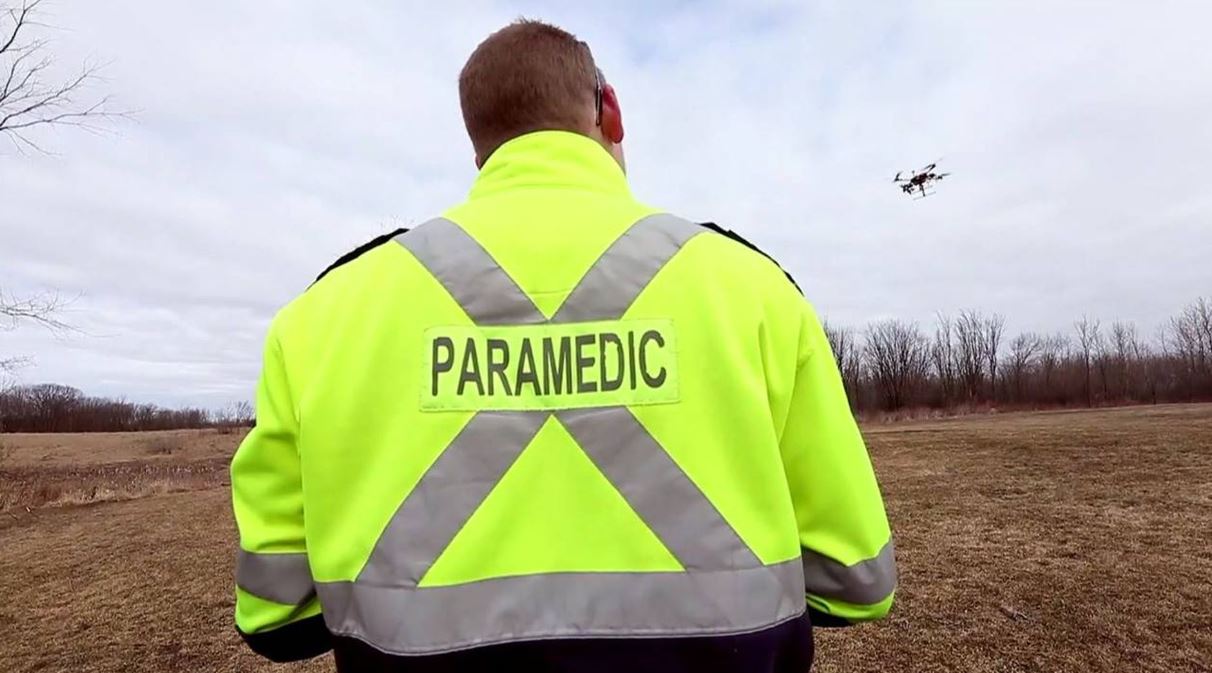The integration of manned and unmanned aircraft in controlled airspace will greatly depend on the ability of UAVs to detect and avoid the presence of other flying objects. The technology to make this happen is already available, but regulators both in the USA and Canada are being very cautious in allowing UAVs to fly beyond visual line of sight (BVLOS). Recent events in the province of Ontario, Canada have changed the perspective around when and how this technology should be opened up for first responders though.
A driver was fatally ejected late last year from a vehicle which rolled off a road in Eastern Ontario’s Renfrew County. Emergency responders were not sure whether there were other victims in the car or the surrounded areas. Terrain around the crash site was difficult to access, with large trees, rocky and steep unexpected drops. Rather than relying solely on emergency staff to determine the number of dead or injured, the county’s paramedic service turned to their UAV.Three years ago, the Renfrew County service became the first among paramedics in Canada to obtain Transport Canada’s permission to fly the drones within the pilot’s line of sight, but for chief paramedic Michael Nolan, the authorization did not go far enough. This particular drone was equipped with a thermal camera, and in its first flight it was able to confirm that the driver was the only casualty.A year before the accident that brought his UAV into the limelight, Nolan began working toward federal approval to fly the drones beyond the pilot’s field of vision – an expanded capability that he said, and has since confirmed, would open the door to a much wider range of uses. After a six-day demonstration before federal officials last spring, the service – along with the Royal Canadian Mounted Police (RCMP), Ontario Provincial Police (OPP) and British Columbia-based drone supplier InDro Robotics - obtained permission to fly UAVs within a four-nautical-mile search area.The green light, granted in the summer, is unprecedented and game-changing.“The program began with off-the-shelf technology that allowed us to test some of the concepts in our own backyard,” Mr. Nolan said, adding that the service drew on the insights of a county paramedic who had experience flying UAVs for the Canadian military. “At the time, the regulations and use of drones were very limited to hobbyists, but we recognized there was greater opportunity to enhance both the technology and the use of drones in the emergency-services context.”In the months since obtaining the expanded federal permission, Renfrew paramedics have used their UAVs to scan rugged crash sites, locate people lost in the woods, and determine whether snowmobilers plummeted through ice or made it safely to shore.The need has not yet arisen, but the service is also capable of deploying a drone to deliver an automatic external defibrillator (AED) to someone in cardiac arrest. A similar effort is being carried out in Nevada by drone manufacturer Flirtey in partnership with ambulance company REMSA.The Renfrew paramedics can also equip a drone with a personal flotation device and lower it to someone struggling in a body of water, similar to the rescue just carried out by an Australian UAV, or use it to throw a rope out to a person stuck on a treacherous stretch of ice to allow paramedics to then pull the person ashore. The rescue applications are endless.While police services and some fire departments in Canada have flown drones for years within a pilot’s line of sight to survey scenes and assist with emergency response, Mr. Nolan said his understanding is that his team is still the only paramedic service with UAVs currently in use. The service is unique in Canada amongst emergency responders, as only the RCMP and OPP are similarly certified, he said.Renfrew is a natural place to deploy this sort of innovation to assist with emergency response efforts. Spanning an area of more than 7,500-square-km, it is the largest county in Ontario and it has more than 900 lakes and four river systems. This beautiful but challenging landscape can slow down conventional rescue efforts.The unmanned vehicle involved in the Renfrew crash site was the result of five design iterations and consisted of a four-kilogram drone with a wingspan of roughly 4.5 feet and a speed roughly as fast as Transport Canada’s 86-km-an-hour limit carrying payloads up to 2.5 kg or 5 lbs.Transport Canada said it will continue to consider new and safe opportunities in drone technology, saying in an e-mail that the department is “working with industry partners to explore and integrate innovative uses into Canada’s transportation system of tomorrow.”With every single new case like and BVLOS approval like this we get closer to the day when responsible operators can do their jobs more efficiently and safely using their UAVs. Emergency response professionals have demonstrated what kind of a difference this usage will make in their efforts, and being able to do so in a shared sky will ensure that a variety of users will see a similar impact.Subscribe
The information you submit will be stored and used to communicate with you about your interest in Commercial UAV News. To understand more about how we use and store information, please refer to our privacy policy.
January 29, 2018
Paramedics in Canada Using Drones Approved for Flying BVLOS















Comments